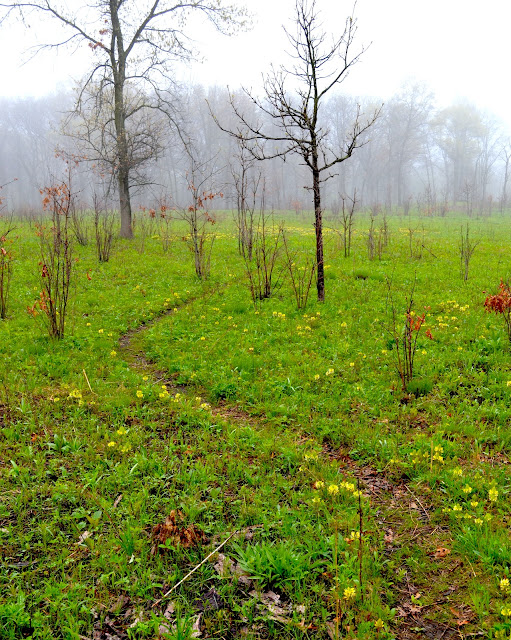Update
The damage to native pollinators by commercial honeybees at Underwriters Labs continues.
The bulldozing along Dundee Road was done by a contractor working for the Village of Northbrook, according to Forest Preserve staff who report that they are have reached a mitigation agreement. Funds from the contractor will be used by the Forest Preserve to pay for the Chicago Botanic Garden to raise plant plugs (both rare species and "workhorse/recovery" species - raised from local seeds supplied by the volunteers) to repair and mitigate for the damage.
The refuse deposited along Waukegan Road was promptly removed by the Village. As stewards, our relationship with the Village has always been excellent, and they've helped out many times.
Original Post: May 17, 2024
A lot of people care about the Northbrook Forest Preserves, but “the team” that exists has worked mostly on conserving plants and animals with our hands in dirt, seeds, and science. That’s what they’re “wired” for. Advocates are needed too.
This week shook us awake.
- Heavy equipment damaged both Somme Prairie and Somme Prairie Grove along Dundee Road.
- Damaging honeybee hives were found adjacent to Somme Prairie on Underwriters property.
- A beekeeper illegally (and damagingly to rare native bees) installed a commercial honeybee hive in Somme Prairie Grove.
- Heavy landscaping refuse was found by the Northbrook village sign along the edge of Waukegan Road in Somme Prairie Grove.
- Appalling piles of garbage were hauled off by a valiant team that included two elected officials, which led to a revised “Walk-light” initiative to ease crossing Waukegan Road from Somme Woods to Somme Prairie Grove.
- Then a snag emerged in the Walk-light initiative.
Some people say, “The Forest Preserve has staff. Why can’t they handle these things?” Answer: Many FP staff work hard on these things and do a great job (as you’ll see reflected below). But with 70,000 acres in a major metro area and small staff, they need and appreciate help.
Read on.
Thirteen commercial Honeybee hives may destroy native pollinator populations.
These thirteen commercial honeybee hives are badly depleting pollen and nectar from the two Somme Nature Preserves, just across the fence. These prairie and savanna preserves barely support small populations of the rusty-patch bumblebee and other rare pollinator. For more detail and how to help, click here.
Heavy equipment damaged both Somme Prairie and Somme Prairie Grove along Dundee Road.
This contractor company (and whoever employed them) should have coordinated with both the Forest Preserve District and the Illinois Nature Preserves Commission before working adjacent to either of the two Somme Nature Preserves. They did not.
What’s going on here? The streets were blocked and there was no parking anywhere near, but it was obvious from the car that damage was being done.
As soon as they heard about it, the Forest Preserve staff demanded that the project be shut down and sent surveyors who marked the preserve boundary. Serious damage had already been done.
Apparently they hadn’t noticed the 5’ x 8’ sign that reads “Somme Prairie Nature Preserve – Restoring original prairie habitat for native plants and animals” and also giving Forest Preserve contact info.
East of the Metra tracks, Somme Prairie Grove Nature Preserve was similarly damaged.

This area might look like “a lot of brush” – and indeed it was mostly buckthorn. But this is a thicket that we’ve been working for years to restore to natural quality. The shrubs here include American plum, choke cherry, and young oaks. Nearby the restoration thrives with hazelnut, elderberry, indigo bush, Illinois rose, and many others.

This is the edge of the damaged area in Somme Prairie Grove. If you look close, and we do look close, along the edges of the bulldozed former remnant community you can see surviving wild geranium, mayapple, prairie trillium, Pennsylvania sedge, starry false Solomon’s seal, Chicago leek, and many more. Perhaps equally important, this is an area that was never plowed; it has original soil, not bulldozed clay. Restoration would have done well here. It will still do well, but it will take more time and work.
We asked the question, “Will there be compensation for the damage done?” Apparently, it wasn’t yet being asked. It may take a person continuing to keep focus on it and trouble-shoot as needed.
Five other challenges emerged this week as well … to be described in future blog posts.
There aren’t currently enough volunteer advocates to cope with all these things. This beautiful and important preserve deserves better. If you might be interested in lending a hand, let us know at info@sommepreserve.org.
We’ll post more on those other issues. Great credit goes to all staff and volunteers involved.
And finally, three recent photos from Somme, to remind you of the stakes.
Acknowledgements
Thanks to the Forest Preserve District of Cook County for buying the land and then doing the best that a small staff can to protect and manage it ... and then being good partners for citizen volunteers who want to help out.
Thanks to Eriko Kojima for proofing and edits of this post.






























